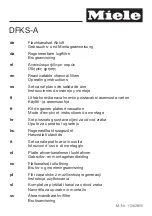
Trouble Shooting Guide
Problem
Solution
High TDS after
membrane
Clogged Pre-filters. Causing Pressure Drop. Insufficient pressure will
yield poor TDS rejection from RO membranes. Change Pre-Filters.
Low incoming water
pressure.
Incoming water pressure must be above 40 PSI, Add a booster pump if
below 40psi. Make sure Pre-Filters are not clogged causing low
pressure.
Reverse Osmosis
membrane has
exhausted/failed.
Average Membrane life is 2 to 3 years. Most common cause for
membrane failure is insufficient pre-filter maintenance. AquaFX Carbons
are rated for 3,750 gal @ 1.0 GPM of 2ppm Chlorine. Do not exclude
drain water from this capacity, as it is treated water. Very high TDS
(>550ppm) may also yield premature failure.
No water to drain.
Flow Restrictor is clogged, Replace Drain Flow Restrictor. (rare)
Check to see if water is turned on.
All water is going out
of the drain
With no back pressure, most of the water will exit out of the drain. Make
sure External Flow restrictor is present.
Very little/slow water
production
Reference units flow rate vs. actual production. Slow flow from RO is
normal. Cold water, low pressure and high contaminant levels will
contribute to decreasing the rate of water production. Heating water,
increasing pressure or additional pre-filtration will help to counteract
these adverse affects.
Drain Water
Continues After
Product line is full
The most common cause of a ‘continuing drain’ is a pressure leak on the
product side of the RO. If the pressure cannot build, the ASO will not
close. Check ASO with a ball valve right after RO. Close Ball valve then
wait 1-3 minutes. If drain continues, replace Automatic Shut-Off Valve. If
it stops, have the customer, find then stop pressure leak. If a float valve
is being used, it is more than likely the culprit.
The incoming feed
water TDS has
increased.
An increase in feed water TDS will also give an increase in Product
Water TDS.
R.O. (Dolphin) Users will see this rise in TDS.
RO/DI (Barracuda, Mako, Great White) Users will not see this rise, but
the DI will exhaust faster than
normal.
DI is exhausting very
fast
R.O. Membranes are manufactured with a preservative on them, if your
initial startup allows the membrane to ‘rinse’ into the DI; there will be
some immediate exhaustion, followed by normal exhaustion.
Chloramines Vs Chlorine – If the customers water is disinfected with
Chloramines (NH2CL) the compound will still be present post RO.
For R.O. (Dolphin) users, they may wish to purchase DI to remove the
compound. There will also be other methods discussed for during
training.
RO/DI (Barracuda, Mako, Great White) users will have the compound
removed by the DI. This will tax the DI, Chloramines appears in several
forms, so the decreased life would depend on the strain of Chloramine.
(mono, di or tri)
Summary of Contents for Octopus RO/DI
Page 4: ......

























